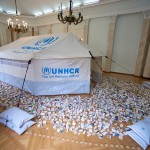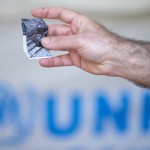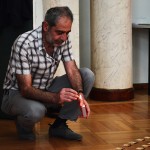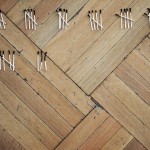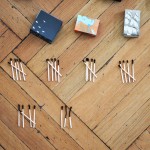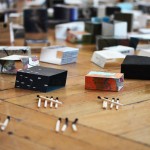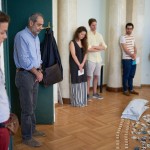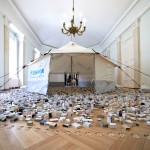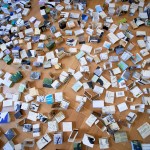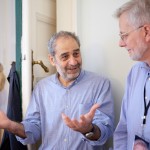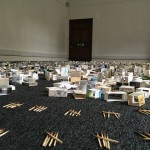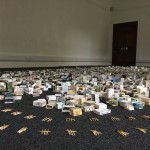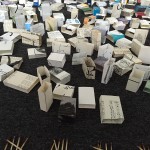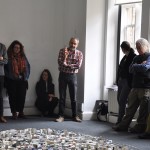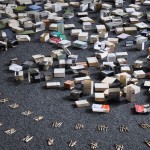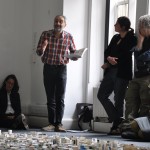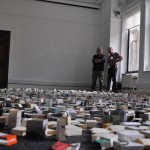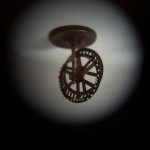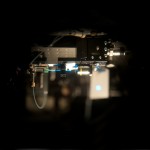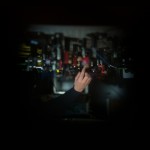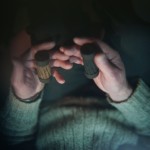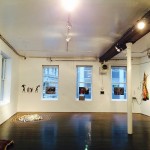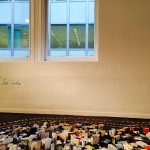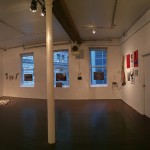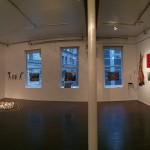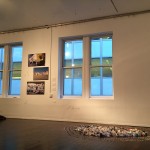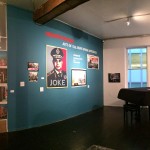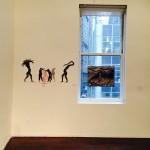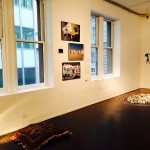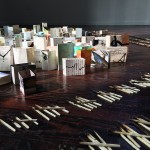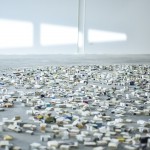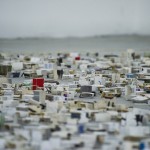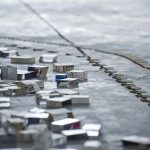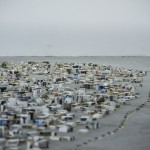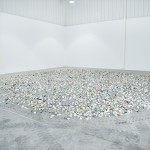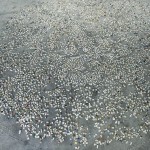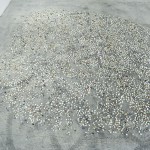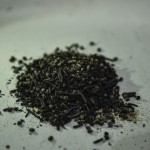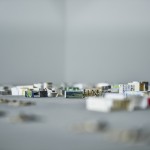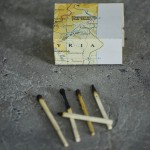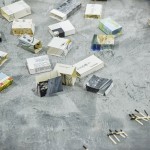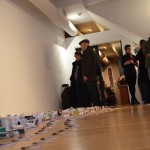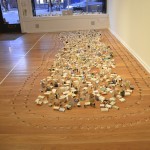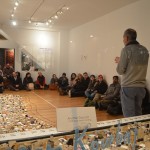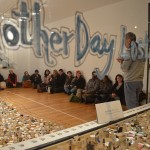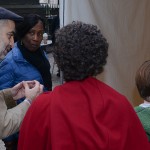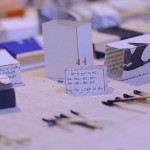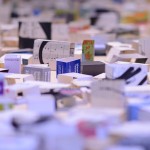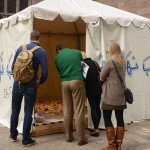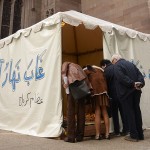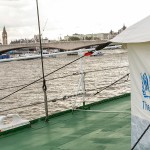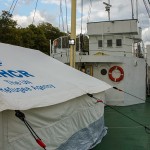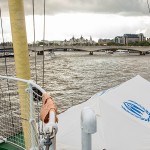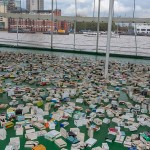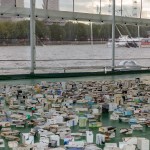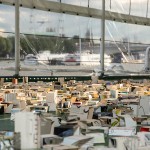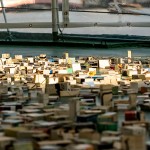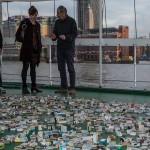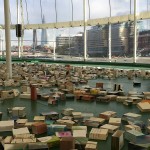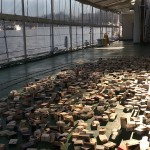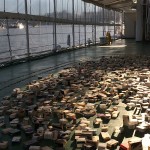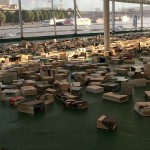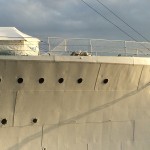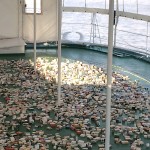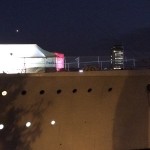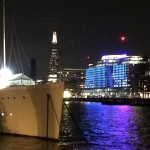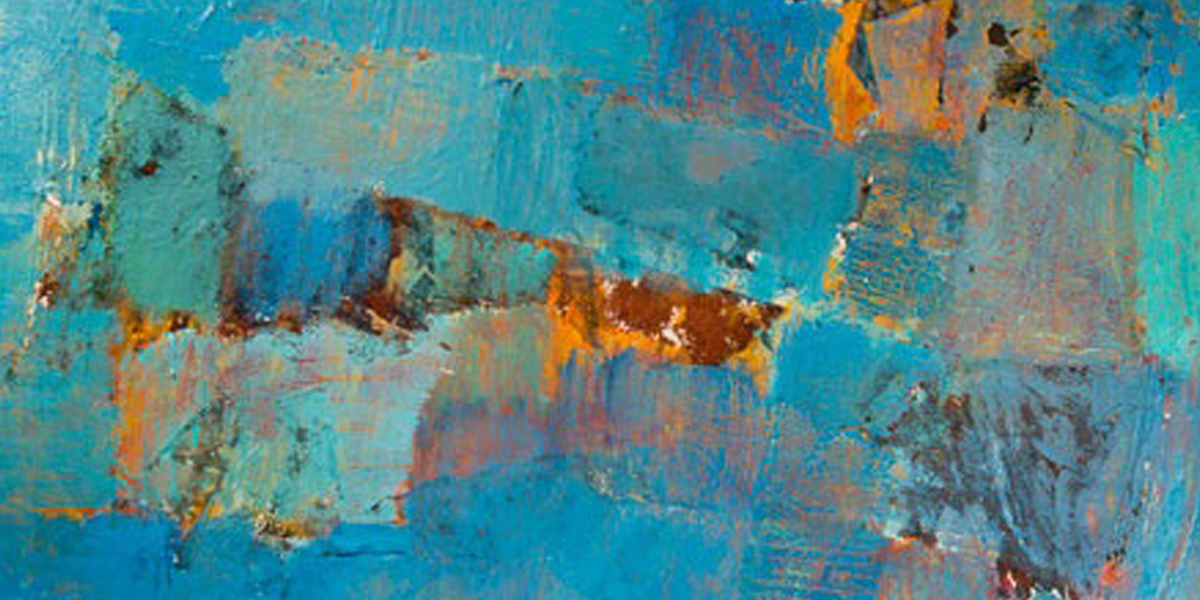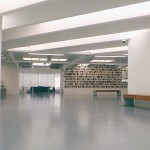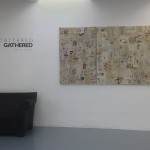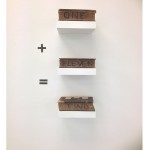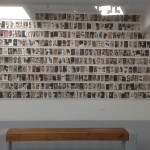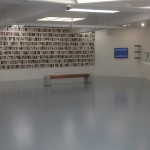Another Day Lost: 1,888 and counting…
Into boundless space I leap
Issam Kourbaj has created a new set of photographs using a camera obscura (Latin for ‘dark room’). The optical device uses a hole (or lens in this case) to project an image of its surroundings into a darkened box; the image appears inverted due to the travel of light in straight lines. Kourbaj’s atmospheric images record some of the activity that takes place in the Maxwell Centre’s laboratories 15 and working spaces, ranging from Maxwell’s historic instruments to the study of light and development of new superconducting materials by contemporary scientists.
Another Day Lost: 1,849 and counting…
Another Day Lost: 1,826 and counting…
Taking the title of a Fairouz song, Another Day Lost is a series of installations by Syrian-born, UK-based artist Issam Kourbaj, inspired by the refugee crisis and made out of discarded books, sheet music, aerial photography, maps, medicine packaging and matches.
The overall appearance is that of a vast refugee ‘camp’, constructed from thousands of tiny paper and cardboard ‘tents’, many of which are marked with Kourbaj’s distinctive black lines (based on Arabic calligraphy and traditional mourning ribbons), and encircled with a ‘fence’ of matches.
The matches are burned as time passes, and arranged in tally marks to count the days: one burnt match for every day since the beginning of the Syrian uprising (15th March, 2011). Meanwhile, the new matches represent the uncertain future.
By repurposing discarded, commonplace materials, Kourbaj laments not only the loss of time, normality and everyday life for Syrians everywhere, but also the poor quality of life experienced by his compatriots in their displacement.
This will be the 9th edition of Another Day Lost, installed here to mark the fifth anniversary of the Syrian uprising (15th March, 2016). There will be a match burning ceremony every day at noon to add to the artwork and to commemorate the countless Syrian lives lost over the last five years.
Issam Kourbaj was born in Syria, and studied in Damascus, St. Petersburg and London. He is based in Cambridge, UK, where he is a Lector in art. Since 2011, he has been making works inspired by and based upon the worsening crisis in his home country.
Another Day Lost: 1,808 and counting…
“transform(art)ive”: Art for Social Change is a series of 1 to 7 days of art exhibitions or provoked expression in conjunction with talks panel & discussions on issues of social justice, engaging and inspiring the community into critical thinking and empathetic understanding of the world around us. Issam Kourbaj’s project “Another Day Lost…”, curated by Louisa Macmillan and brought to 12G by Amina Ahmed is the first in this new series of exhibitions.
Another Day Lost is a series of installations by Syrian-born, UK-based artist Issam Kourbaj, inspired by aerial images of refugee camps and is made out of waste materials. Each installation is constructed from discarded books, medicine packaging and burnt matches. As one of the visitors in London commented: “Waste materials portraying wasted lives.” The overall appearance is that of a refugee ‘camp’, made out of thousands of tiny paper and cardboard ‘tents’, some of which are marked with Kourbaj’s distinctive black lines (based on Arabic calligraphy and traditional mourning ribbons), and encircled with a ‘fence’ of burnt matches.
The used, redundant matches reference not only the irreversible changes in everyday Syrian life but also the loss of thousands of lives. The matches are arranged in tally marks, which enumerate the number of days that have passed since the beginning of the Syrian uprising (15th March, 2011), and one match will be added to the artwork for each day while the conflict continues. On 24th February, there will be 1,808 matches.
By repurposing discarded materials and extinguished matches, Kourbaj laments not only the loss of time, normality and everyday life for Syrians everywhere, but also the poor quality of life experienced by his compatriots in their displacement. The installations were initially scattered around central London, in disused spaces and even a UNHCR tent, in a pattern loosely related to the diaspora of refugee camps that have arisen in the countries bordering Syria over the last five years. As the refugee crisis worsened on an international scale, Another Day Lost was also shown aboard a boat on the River Thames and exhibited for the first time in the USA in two tents in the churchyard of Trinity Wall Street, over Christmas 2015 and New Year 2016.
Kourbaj says: “Another Day Lost is an archive of loss and remembrance, not of the distant past, but of the very painful present; a present of lasting scars, abandoned humans and cities turned to dust. More than 1800 days have passed since the Syrian uprising, and the count goes on. Tragically millions of Syrians are still uprooted, displaced and orphaned and many are becoming citizens of a tent.”
Another Day Lost: 1,735 and counting..
Another Day Lost (2015) Paper, cardboard and burnt matches
Curated by Louisa Macmillan
Another Day Lost is a series of installations by Syrian-born, UK-based artist, Issam Kourbaj, inspired by the ongoing Syrian Refugee Crisis.
In the white tent, Another Day (2015), shown here for the first time, is made up of approximately 1,750 burnt matches and one solitary ‘tent’ to highlight the amount of time lost by every individual person, family, city or even Syria itself, since the war began on 15th March, 2011. Kourbaj has spiraled the matches around the lone tent, as numerous as if they were countless, suggesting that the weight of time lost is strangling anyone who might live inside.
In the blue tent, Another Day Lost, inspired by aerial imagery of refugee camps in the Jordan, is shown here for the seventh time. Kourbaj created this ‘camp’ of thousands of ‘tents’ out of waste materials, such as medicine packaging and discarded books, which are marked with his distinctive black lines (based on Arabic calligraphy and traditional mourning ribbons). The ‘camp’ is surrounded by a ‘fence’ of burnt matches, which reference the irreversible changes in everyday Syrian life and the loss of thousands of lives.
Thirdly, in the Parish Center (2 Rector Street), Kourbaj and volunteers have installed a camp inspired by Another Day Lost that is big enough to step into. There is a horizon line or ‘fence’ of matches (paired with the artist’s tents in the entrance), which continues throughout the rest of the center. Members of the community are invited to step into this camp and, using Kourbaj’s process, to participate in making their own tents for the internal walls of the Parish Center. In addition, visitors will be able to use the adjacent computers to send electronic messages to their elected representatives.
Press
Another Day Lost: 1,649 and counting..
Off The Wall is a trans-platform exhibition floating on the Thames, with works by artists from across London. The show is staged aboard the HQS Wellington, a 1933 sloop which has been commanded across the Atlantic and Pacific, moored on the Thames at Victoria Embankment, opposite Temple Tube station. It also features an installation Another Day Lost by UK-based, Syrian artist Issam Kourbaj.
London once established its connections with the globe from the gateway of its river. Off The Wall has chosen to bring its participating artists, who originate from three continents over both hemispheres, all back to the river. The artists in Off The Wall are not bound by a single theme or thread, but freely draw on their individual diverse visions and interpretations. They address history as a spatial challenge and as a physical constraint.
The artist invited come from London colleges including Royal College of Art, Slade School of Fine Art, Camberwell College of Arts, Goldsmiths and Chelsea College of Art. As well as presenting paintings, sculpture, photography, drawing, installations and video, the exhibition will be complimented by a programme of live works.
Sze Wong, Julia Varela, Issam Kourbaj, Matthias Tharang, Ruozhe Xue, Helena Hartmann, Yuki Kobayashi, Nils Alix Tabeling, Zehra Arslan, Cibelle Cavalli Bastos, Miguel Soto, Riikka Hyvönen, Yu Ting ong, Jiaxin Yuan, Sunghun Ryu, Francis Olvez Wilshaw, Hamish Pearch, Girolamo Marri,Kennis Chen, Anna Cheung, Min Kim, Delfina Fantini Van Ditmar, Luli Perez, Justin Fitzpatrick, Macarena Rojas Osterling, Li Li Ren, Jamie Fitzpatrick
The entire exhibition invites donations which will go entirely to Syrian projects run by Doctors Without Borders (MSF UK) and the U.N. Refugee Agency (UNHCR).
INFO.
PREVIEW_ Friday 18th September 2015, 6-11pm
RSVP Essential to offthewallexhibition@gmail.com
PERFORMANCES – SCREENINGS will be happening throughout the Opening evening.
Press
Art Of Resistance
When I began to learn the Arabic alphabet, my almost illiterate mother helped me to learn how to write by holding my hand and making me draw the first letter of my name. This letter ‘ع’, which is pronounced as ‘Ain’ in Arabic, produces a sound exactly equivalent to the word Eye in my mother tongue. Through an almost mystical coincidence, this is also the case in English where the first letter of my name ‘I’ also echoes the sound of the word Eye. Since then I started to learn how to form my artist’s ‘eye’.
To make ends meet, while growing up in the Druze mountains in Syria, I became a boy-calligrapher. At first I assisted my older brother in his projects and later acquired my own ‘clients’. My first proud commission was the shop sign for a popular barber’s shop. And this is how the drawing and design of words, (the art of calligraphy) became my first means of survival and the beginning of my journey into mark-making.
I had no idea when I left Syria that I would one day use fragments of Arabic script in my artwork. Language features prominently in my work Sound Palimpsest, which welled up in reaction to the second invasion of Iraq. In Sound Palimpsest, a group of loose leaf sheets, I tried to capture the fragility of human beings and their bodies and souls against the brutal mindless war machine. I used haunting fragments of walls with children’s graffiti, found text and words from medical debris and X-ray plates, torn parts of books and broken pieces of song. In her introduction to this work for the exhibition Iraq’s Past Speaks to the Present, curator Venetia Porter wrote: ‘Kourbaj is an artist inspired by what transpires around him in the course of daily life, yet he also embraces the non-representational. Lack of confinement by the limits of the paper, canvas and medium allows him absolute creative freedom. He also draws on the expressive and candid reactions observed in children’s art; this could also account for the element of nostalgia that is recognisable in Kourbaj’s work’.
Earlier this year I worked on my Excavating the Present installation, which is a tribute to Syrian mothers. This work is a palimpsest of two different types of camera-less photograms. My raw materials (or found objects) were an assemblage of X-rays produced by invisible electromagnetic radiation, on Mylar plastic coated with light sensitive emulsion. I worked with those to produce a second kind of photogram – produced by visible light on light-sensitive black-and-white paper in a darkroom, and that’s how the work took shape using layers, and archaeology as a baseline.
Frances Carey (formerly Deputy Keeper of Prints and Drawings and Head of National Programmes at the British Museum) described the above installation as follows: “That Kourbaj should favour archaeological metaphor is not surprising for one whose personal history has involved so many layers, translations and re-imaginings. Palimpsest as a metaphor for the ‘excavation’ of memory has a distinguished lineage through Thomas De Quincey and Baudelaire. A true palimpsest is created through erasure then re-inscription, often leaving the ghost of the original image or text behind. This is what the X-ray technique can so powerfully evoke, revealing the shadows of existence and intimations of a deeper meaning or fear”.
As a Syrian artist, I am observing from a very painful distance the evisceration of my homeland, its people, its society, its cities and villages, its past and present, its history and its memory. With every hourly news bulletin I am reminded of the inhuman conditions and atrocities, which courageous women, children and men, are enduring and of the lies and distortions and deletions which mean that many of these atrocities might be forever forgotten, buried like many of the dead, never to be heard of again or remembered. I fear for the future of my people and my country and whether having lost so much they can ever find themselves again, whole and unbroken.
Scattered / Gathered
“The efforts must be made to speak of friendship as of a pure topic: this releases me from the level of affectivity—which could not be spoken without embarrassment since it belongs to the order of the imaginary…” Roland Barthes.
With these sentences which Roland Barthes wrote in his own unconventional autobiography, “Roland Barthes by Roland Barthes” (1977), the two artists, Nizar Sabour and Issam Kourbaj, bind their own biographies in this exhibition. The result is a collection of splendid artists’ books, and then, a collection of scattered memories between the two lifelong friends. The artists assemble an autobiography of their thirty years old friendship apart, displayed and re-gathered in “Scattered, Gathered” at CAP. Being both Syrian however immediately releases the eruptions and inexpressible sorrow caused by the current events in Syria into the exhibition space. Yet this, perhaps, also takes us back to Barthes and his own “Mourning Diary” where he preserved his brief daily jottings of his personal grief and suffering over his mother’s own death. Syria is Sabour’s and Kourbaj’s mother so as to speak, and their diaries mediate into a continuous process of mourning over their diseased and frail country.
The exhibition “Scattered, Gathered” curated by Abed Al Kadiri, strikes viewers with a sense of being suspended between pages of affectivity. While the relationship with books is both a public and private one, similarly, the relationship with grief is one that is at the verge of expressing to the outside and keeping to one’s self. On the one hand, Issam Kourbaj’s visual diaries are superimposed on 10,232 pages of Twelve Volumes of The Encyclopedia Britannica of 1890, and on the other hand, Nizar Sabour’s visual essays are created on eighteen handmade wooden books. Still, both diaries reside between the tensions of the imaginary; those of space and time. While Sabour records the date by the hour of his own diary entries experienced in the folds of the daily life in Syria, Kourbaj inscribes his images onto pages of ready-made collections of alphabetical knowledge, as if the artist is re-writing this knowledge from his own perspective as a Syrian in the UK and recreating a different collective memory.
Both artists present a minimalistic style in their art works. Sabour’s diaries convey panoramic scenes of people, walls, cityscapes and landscapes. His visual elements are portrayed in a childish manner using bright colours as well as different shades of black and white. The written words in his work offer viewers keywords and clues to complete the words of the titles further imagining a narrative of nostalgia. On the other hand, Kourbaj’s books presents no inscribed words but rather a nonlinear narrative. However, the primitive and raw nature of the lines on each page of The Encyclopedia Britannica compile into a story of repetitive shapes, as if creating their own letters and language taking us earlier than the period of 1890 andperhaps into the walls of caves.
The imagery in the diaries by both artists further resembles moments of development and evolution of the life of the two friends who took on their separate ways in different directions. However their diaries kept track of their own perceptions of the events around them. Even themselves as artists, Sabour and Kourbaj, are presented as a work-in process throughout the pages of their own diaries. In “Roland Barthes by Roland Barthes” the text itself is playful and the author inverts his text to become himself its very subject of enquiry. In a similar vein, Sabour and Kourbaj in their own diaries are their own subjects exploring the creation of their own knowledge according to their surrounding.
Proceeds from this exhibition will go towards Al Madad Foundation’s education and literacy programs, on the ground in Aleppo Syria. By equipping Syria’s most vulnerable children and families with the right tools and necessary skills, Al Madad Foundation enables them to rebuild their lives, country and empower a future generation that will not be lost to war. To learn more about this project, click here.


